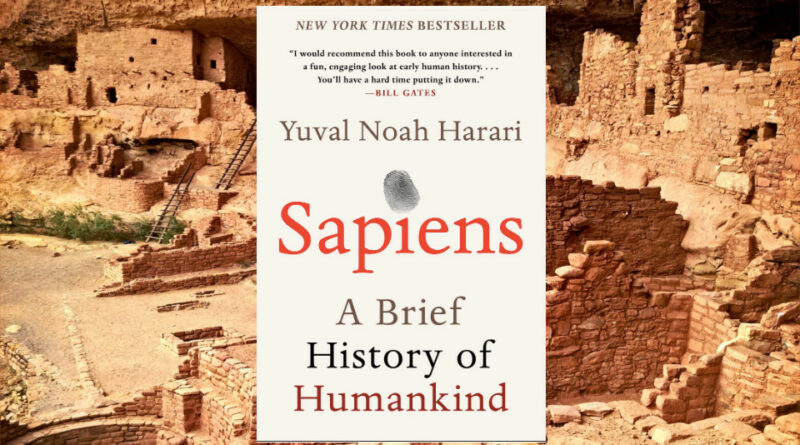Sapiens and the Best Reads
[Please note that this page contains affiliate links. If you choose to purchase after clicking a link, I may receive a commission at no extra cost to you.]
Sapiens and the Best Reads
Sapiens has to be at the top of the top 5 book smart reads to extend your knowledge and build your vocabulary to learn about relevant history.
Sapiens: A Brief History of Humankind by Yuval Noah Harari
He divides the history of Sapiens into four major parts:
- The Cognitive Revolution (c. 70,000 BCE, when Sapiens evolved imagination).
- The Agricultural Revolution (c. 12,000 BCE, the development of farming).
- The Unification of Humankind (the gradual consolidation of human political organizations towards one global empire).
- The Scientific Revolution (c. 1500 CE, the emergence of objective science).
Harari’s main argument is that Sapiens came to dominate the world because it is the only animal that can cooperate flexibly in large numbers.
He argues that prehistoric Sapiens was a vital cause of the extinction of other human species, such as the Neanderthals, along with numerous another megafauna.
He further argues that the ability of Sapiens to cooperate in large numbers arises from its unique capacity to believe in things existing purely in the imagination, such as gods, nations, money and human rights.
Harari claims that all large-scale human cooperation systems – including religions, political structures, trade networks and legal institutions – owe their emergence to Sapiens’ distinctive cognitive capacity for fiction.
Accordingly, Harari reads money as a system of mutual trust and sees political and economic systems as more or less identical to religions.
In discussing the unification of humankind, Harari argues that the trend for Sapiens has increasingly been towards political and economic interdependence over its history.
For centuries, most humans have lived in empires, and capitalist globalization effectively produces one global empire.
In Sapiens, Harari argues that money, empires and universal religions are the principal drivers of this process.
He concludes by considering how modern technology may soon end the species as we know it, as it ushers in genetic engineering, immortality and non-organic life.
In Harari’s chosen metaphor, humans have become gods: they can create species.
Rating: 5/5
Guns, Germs, and Steel by Jarod Diamond
Like Sapiens, Guns Germs and Steel does a great job of giving accurate and exciting histories of humanity.
The prologue opens with Diamond’s conversation with Yali, a New Guinean politician.
The conversation turned to the apparent differences in power and technology between Yali’s people and the Europeans who dominated the land for 200 years, differences that neither of them considered due to any genetic superiority of Europeans.
Yali asked, using the local term “cargo” for inventions and manufactured goods, “Why is it that you white people developed so much cargo and brought it to New Guinea, but we black people had little cargo of our own?” (p. 14)
Diamond realized the same question seemed to apply elsewhere: “People of Eurasian origin … dominate … the world in wealth and power.” Yet, after having thrown off colonial domination, other peoples still lag in wealth and power.
Still others, he says, “have been decimated, subjugated, and in some cases even exterminated by European colonialists.” (p. 15)
The peoples of other continents (sub-Saharan Africans, Native Americans, Aboriginal Australians and New Guineans, and the original inhabitants of tropical Southeast Asia) have been primarily conquered, displaced and, in some extreme cases – referring to Native Americans, Aboriginal Australians, and South Africa’s indigenous Khoisan peoples – largely exterminated by farm-based societies such as Eurasians and Bantu.
He believes this is due to these societies’ technological and immunologic advantages, stemming from the early rise of agriculture after the last Ice Age.
In short: basically, everyone who has ever lived in the last 13,000 (since the last ice age) has succumbed to disease, been killed by guns, or died looking for metal.
Similar to Sapiens – Guns, Germ, and Steel point out history and make connections that we see first.
The Tipping Point: How Little Things Can Make a Big Difference
by Malcolm Gladwell
Gladwell outlines a simple three-point plan to get your product to its tipping point using the three basic laws of epidemics.
- The Law of the Few
An epidemic begins when a few highly infectious individuals become viral vectors for a product or idea by adopting it themselves and spreading the word.
- The Stickiness Factor
The epidemic spreads when the contagious agent, the product, is naturally infectious or ‘sticky’ to use the broadcasting term.
A show is ‘sticky’ when we don’t want to switch channels.
Gladwell gives examples from television and books to show how minor tweaks to increase relevance, talk-ability, and memorability can significantly affect success.
- The Power of Context
Finally, the spread of an epidemic will depend on whether the context is proper.
Ideas and products that fit the context into which they are launched spread fast and wide, while others that don’t provide their context don’t apply.
Rating: 4/5
Blink: The Power of Thinking Without Thinking by Malcolm Gladwell
Gladwell eloquently points out that the average person decides within 2 seconds of being presented with something.
He teaches people to step back and think more critically before making decisions.
The author describes the main subject of his book as “thin-slicing”: our ability to use limited information from a very narrow period of experience to conclude.
This idea suggests that spontaneous decisions are often as good or even better than carefully planned and considered ones.
The book argues that intuitive judgment is developed by experience, training, and knowledge – Knowledge is Power!
Rating: 4.5/5
Outliers: The Story of Success by Malcolm Gladwell
Gladwell examines:
- Most Canadian ice hockey players are born in the first few months of the calendar year.
- What it took for Microsoft co-founder Bill Gates achieved his extreme wealth.
- How The Beatles became one of the most successful musical acts in human history
- Why Joseph Flom built Skadden, Arps, Slate, Meagher & Flominto one of the most successful law firms in the world
- How cultural differences play a large part in perceived intelligence and rational decision-making
- How two people with exceptional intelligence, Christopher Langan and J. Robert Oppenheimer, end up in vastly different fortunes.
Throughout the publication, Gladwell repeatedly mentions the “10,000-Hour Rule”, claiming that the key to achieving world-class expertise in any skill is, to a large extent, a matter of practicing the correct way for a total of around 10,000 hours.
However, the authors of the original study this was based on have disputed Gladwell’s usage.
Rating: 4/5


